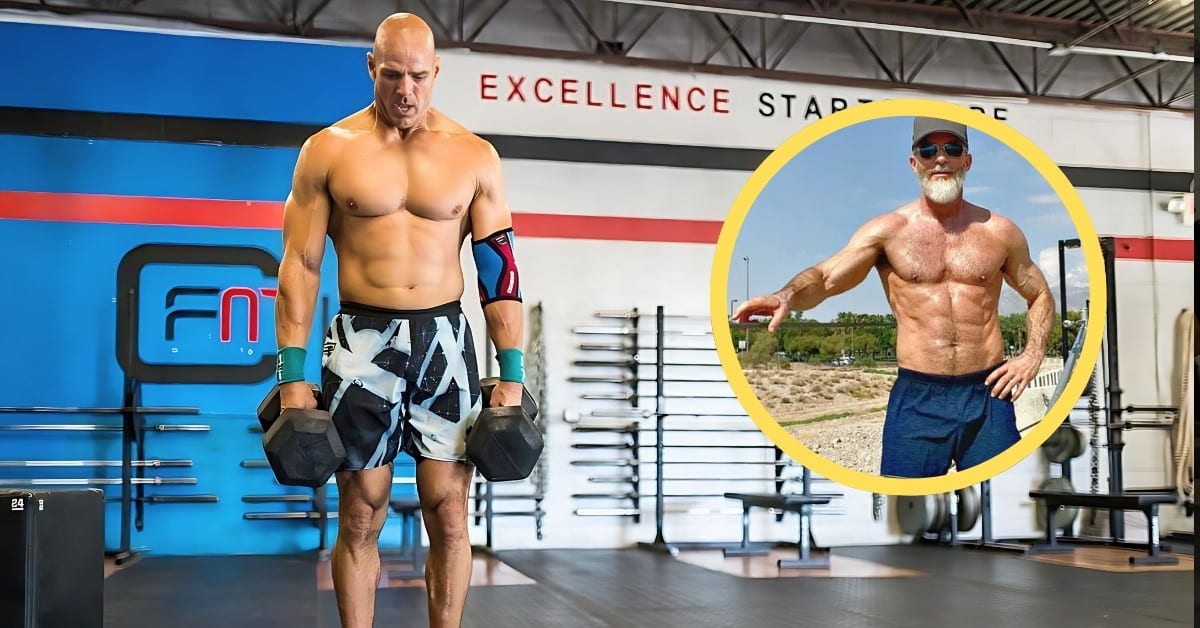Feeling sluggish and out of shape? If you’re a man over 50, there’s good news: It’s never too late to reclaim your energy and fitness! This 30-day plan is your blueprint to building muscle, burning stubborn belly fat, and feeling years younger – just in time for summer.
Forget fad diets and impossible workouts! This plan is designed specifically for men over 50 to deliver real results. Discover how to boost your metabolism, build strength, and feel more energized than you have in years.
Ready to get strong and feel your best? Read on to jumpstart your fitness transformation!
Jump to:
Why Fitness Matters Even MORE After 50
Metabolic Changes
As you age, your metabolism naturally slows down, muscle mass decreases, and hormonal shifts can complicate weight management efforts. Understanding these changes is crucial as it helps you adjust your fitness strategy to counteract them effectively.
Longevity Benefits
Staying active is a key factor in reducing the risk of age-related diseases such as diabetes and heart disease. More than just warding off illnesses, regular strength training can help maintain bone density and prevent injuries, making everyday activities easier and less risky.
Confidence and Vitality
The mental benefits of fitness are significant. Feeling strong and capable can dramatically improve your mental outlook and has a positive effect on all facets of life, from personal relationships to professional engagements.
The Foundations of Your Fitness Reboot
Prioritize Strength Training
Building muscle is essential not only for appearance but for boosting your metabolism and maintaining functional strength. This part of the plan focuses on resistance training that enhances fat loss and muscle maintenance.
Nutrition Fundamentals
A balanced diet is key. This plan emphasizes the importance of whole foods, lean proteins, and abundant vegetables while recommending a reduction in processed food intake. The goal here is not to restrict but to optimize.
Incorporate Cardio
While extreme workouts can be unsustainable and daunting, this plan incorporates moderate-intensity cardio exercises such as walking, cycling, and swimming. These activities help improve cardiovascular health and are sustainable long-term.
Recovery is Vital
Recovery strategies like adequate sleep, proper hydration, and stress management play a crucial role in the success of any fitness plan. Stretching and mobility work are also included to help prevent injuries and aid muscle recovery.
The 30-Day Action Plan
Week 1: Build the Base
Strength Workouts
The goal for the first week is to lay a strong foundation with full-body strength workouts that target major muscle groups. Here is a detailed workout template you can follow. Each session should begin with a 5-10 minute warm-up (light jogging, dynamic stretches).
Workout A:
- Squats (3 sets of 10 reps) – Use a comfortable weight to ensure proper form. This exercise builds your quadriceps, hamstrings, and glutes.
- Bench Press (3 sets of 10 reps) – Focus on chest, shoulders, and triceps.
- Bent Over Rows (3 sets of 10 reps) – Strengthens the back and biceps.
- Plank (3 sets of 30 seconds) – Core strengthening.
Workout B:
- Deadlifts (3 sets of 10 reps) – Targets the lower back, glutes, and legs.
- Overhead Press (3 sets of 10 reps) – Works the shoulders and upper arms.
- Pull-Ups or Assisted Pull-Ups (3 sets of as many reps as possible) – Focuses on upper body strength.
- Leg Raises (3 sets of 15 reps) – For lower abs.
Workout C:
- Lunges (3 sets of 10 reps per leg) – Excellent for leg and core stability.
- Push-Ups (3 sets of 10-15 reps) – A good all-around upper-body exercise.
- Seated Rows (3 sets of 10 reps) – Back and biceps.
- Russian Twists (3 sets of 20 reps) – Core rotation movement.
Rotate between these workouts (A, B, C) throughout the week, aiming for three sessions total.
Cardio Sessions
Incorporate 2-3 moderate cardio sessions spread throughout the week. Each session should last between 20-30 minutes and can include any of the following activities:
- Brisk Walking – A steady and easy pace to get your heart rate up without going overboard.
- Cycling – Either on a stationary bike or an outdoor route, maintain a moderate pace.
- Swimming – Gentle laps in the pool focusing on consistency rather than speed.
Nutrition Plan
Nutrition is crucial for fueling your workouts and recovery. Here’s a simple daily eating plan to start with:
Breakfast:
- Oatmeal with a scoop of protein powder, berries, and a teaspoon of flaxseed.
- Green tea or black coffee.
Lunch:
- Grilled chicken salad with mixed greens, cherry tomatoes, cucumbers, and vinaigrette dressing.
- Whole-grain roll.
Snack:
- A small handful of almonds and an apple.
- Hydrate with water or an electrolyte drink, especially after workouts.
Dinner:
- Baked salmon with asparagus and quinoa.
- A side salad with lemon juice dressing.
Evening Snack:
- Greek yogurt with a sprinkle of chia seeds.
This meal plan emphasizes proteins for muscle repair, complex carbohydrates for energy, and healthy fats for inflammation reduction and heart health. Adjust portion sizes and ingredients based on your specific caloric needs and dietary restrictions.
Weeks 2 & 3: Increase the Challenge
As you move into the second and third weeks of your fitness reboot, the goal is to incrementally increase the intensity and complexity of your workouts. This progressive challenge helps prevent plateaus and continuously advances your fitness and strength gains. Here’s how to structure your workouts, cardio sessions, and nutrition to effectively raise the bar.
Enhanced Strength Workouts
We will modify the initial workouts by adding variations, increasing weights, and incorporating more sets to intensify the challenge. Continue to alternate between Workout A, B, and C, but with the following adjustments:
Workout A:
- Squats – Increase to 4 sets of 12 reps with slightly more weight.
- Bench Press – 4 sets of 12 reps. Add a small increment (5-10 lbs) to the weight used in Week 1.
- Bent Over Rows – 4 sets of 12 reps, increasing the weight as in the bench press.
- Plank – 3 sets, but now hold each for 40 seconds.
Workout B:
- Deadlifts – Progress to 4 sets of 12 reps. Increase the weight by 10-15 lbs from what was used initially.
- Overhead Press – 4 sets of 12 reps; add more weight to challenge your upper body.
- Pull-Ups or Assisted Pull-Ups – Aim for 4 sets this time, increasing the number of reps you can manage in each set.
- Leg Raises – Increase to 4 sets of 20 reps for added abdominal challenge.
Workout C:
- Lunges – Do 4 sets of 12 reps per leg, possibly adding dumbbells for extra resistance.
- Push-Ups – Increase to 4 sets of 20 reps to strengthen the chest, shoulders, and arms.
- Seated Rows – 4 sets of 12 reps, with an increase in weight.
- Russian Twists – Up to 4 sets of 25 reps with a medicine ball for added resistance.
Progressive Cardio Sessions
Cardiovascular endurance will be pushed further by increasing either the duration or intensity of your cardio workouts.
- Brisk Walking – Extend the duration to 35 minutes and try to cover more ground in that time.
- Cycling – Increase the session to 30 minutes and incorporate some hillier routes or use a higher setting on a stationary bike.
- Swimming – Increase the lap count each session and try to reduce the rest time between laps for a continuous swim.
Advanced Nutrition Plan
As your exercise intensity increases, so too should your nutritional support. Focus on high-quality proteins, complex carbohydrates, and hydration to aid recovery and fuel the added demands on your body.
Breakfast:
- Scrambled eggs with spinach and mushrooms, served with whole-grain toast.
- A protein shake made with almond milk, protein powder, a banana, and a spoonful of peanut butter.
Lunch:
- Turkey or chicken breast wrap with hummus, bell peppers, cucumbers, and lettuce in a whole wheat tortilla.
- Side of mixed berries.
Snack:
- Cottage cheese with pineapple chunks.
- A hydration smoothie with coconut water, lime juice, and a pinch of salt.
Dinner:
- Grilled lean steak or tofu with a side of sweet potatoes and steamed broccoli.
- Salad with mixed greens, avocado, nuts, and a balsamic dressing.
Evening Snack:
- A small bowl of air-popped popcorn seasoned with a sprinkle of nutritional yeast.
This enhanced diet plan provides a balanced mix of macronutrients to support increased physical activity and muscle recovery. Protein intake is crucial for muscle repair, while healthy fats and carbs provide sustained energy.
Week 4: Finish Strong
The final week of your 30-day fitness reboot is all about pushing the boundaries and solidifying the gains you’ve made in the previous weeks. This week, you will increase the intensity of your workouts, focus intensely on recovery practices, and reflect on the lifestyle changes you’ve implemented. Here’s a detailed plan to help you finish strong.
Intensified Strength Workouts
This week, maximize your effort in the gym by adding more weight and incorporating advanced techniques to enhance muscle engagement and endurance. Stick to the same workout structure (A, B, C) but with these intensified modifications:
Workout A:
- Squats – Perform 4 sets of 15 reps at a higher weight. Focus on deep, controlled movements to maximize muscle engagement.
- Bench Press – 4 sets of 15 reps with increased weight. Consider using a slow eccentric phase (lowering the bar slowly) to increase tension.
- Bent Over Rows – 4 sets of 15 reps. Increase the weight and incorporate a pause at the top of each row for added difficulty.
- Plank – Hold for up to 60 seconds for 3 sets, focusing on tightening your core throughout the hold.
Workout B:
- Deadlifts – 4 sets of 15 reps with added weight. Ensure your form remains strict to avoid any injuries.
- Overhead Press – 4 sets of 15 reps; increase the load slightly from the previous week.
- Pull-Ups or Assisted Pull-Ups – Increase the number of reps per set as much as possible.
- Leg Raises – Perform 4 sets of 25 reps. Try raising your legs higher to intensify the core activation.
Workout C:
- Lunges – 4 sets of 15 reps per leg with added dumbbell weight. Maintain balance and focus on a full range of motion.
- Push-Ups – Aim for 4 sets of as many reps as possible (AMRAP), pushing your limits safely.
- Seated Rows – 4 sets of 15 reps with increased weight, focusing on a slow release.
- Russian Twists – 4 sets of 30 reps using a heavier medicine ball.
Advanced Cardio Sessions
Elevate your cardiovascular workouts by adding intensity or extending the duration to push your endurance limits.
- Brisk Walking – Walk for 40 minutes with intervals of increased pace every 5 minutes to boost intensity.
- Cycling – Continue for 35 minutes, incorporating interval training with bursts of high speed followed by moderate pacing.
- Swimming – Aim to swim for longer distances without breaks, focusing on maintaining a steady, fast pace.
Comprehensive Recovery Focus
Recovery is crucial, especially as you intensify your workouts. Focus on these key recovery techniques:
- Stretching and Flexibility Workouts: Dedicate at least 20 minutes after each workout to stretch all the major muscle groups you’ve worked. Incorporate yoga sessions if possible to improve flexibility and reduce muscle tightness.
- Foam Rolling: Spend 10-15 minutes daily on foam rolling exercises to help reduce muscle soreness and improve blood flow.
- Extra Sleep: Aim for 8-9 hours of quality sleep per night to allow optimal muscle recovery and growth.
Reflective Nutrition Strategy
This week, your nutrition needs to support your intensified workouts and enhanced recovery efforts.
Breakfast:
- High-protein omelet with spinach, tomatoes, and mushrooms.
- A smoothie with banana, blueberries, Greek yogurt, and a spoonful of almond butter for healthy fats and protein.
Lunch:
- Quinoa and grilled chicken breast salad with lots of greens, nuts (for healthy fats), and cranberries.
- A side of avocado for extra omega-3 fatty acids.
Snack:
- Protein bars or a shake to quickly replenish energy stores post-workout.
- Fresh carrot sticks with hummus for a quick refuel.
Dinner:
- Grilled salmon with a side of roasted vegetables and wild rice. Salmon is rich in protein and omega-3 fatty acids, excellent for recovery.
- A small bowl of mixed fruit for dessert to satisfy sweet cravings healthily.
Evening Snack:
- Casein protein shake or a small bowl of cottage cheese with honey and nuts. Casein provides a slow-release protein source ideal for overnight muscle repair.
By adhering to this detailed plan during the final week, you will maximize your fitness gains, enhance your recovery, and set the stage for ongoing health and fitness maintenance. This rigorous approach ensures that you finish the 30-day challenge strong and with noticeable improvements in both physical and mental fitness.
Success Beyond Summer
Habits Not Hustle
Adopting sustainable, enjoyable changes is more effective for long-term success than quick fixes. This plan encourages a steady approach to fitness that feels manageable and fulfilling.
Finding Your Fitness Community
Whether it’s at the gym, in group classes, or with a walking buddy, finding like-minded individuals for support can significantly enhance your motivation and enjoyment.
Staying Motivated
Set goals that aren’t just about weight loss. Use other metrics like how your clothes fit or your overall energy levels to track your progress. These can serve as powerful motivational tools to keep you moving forward.














